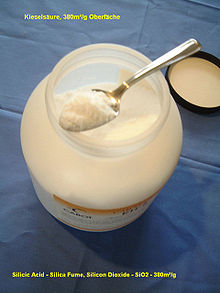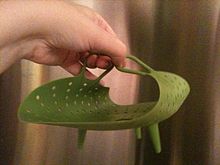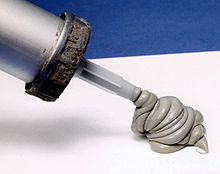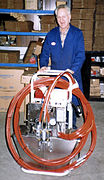- Silicone
-
Not to be confused with the metalloid chemical element Silicon.
Silicones are inert, synthetic compounds with a variety of forms and uses. Typically heat-resistant and rubber-like, they are used in sealants, adhesives, lubricants, medical applications (e.g., breast implants), cookware, and insulation.
Silicones are polymers that include silicon together with carbon, hydrogen, oxygen, and sometimes other chemical elements. Some common forms include silicone oil, silicone grease, silicone rubber, and silicone resin.
Contents
Properties
Some of the most useful properties of silicones include:
- Low chemical reactivity.
- Low toxicity.
- Thermal stability (constancy of properties over a wide temperature range of −100 to 250 °C).
- The ability to repel water and form watertight seals, although silicones are not hydrophobes.
- Excellent resistance to oxygen, ozone, and ultraviolet (UV) light such as that in sunlight. This property has led to widespread use of silicones in the construction industry (e.g. coatings, fire protection, glazing seals) and the automotive industry (external gaskets, external trim).
- Good electrical insulation. Because silicone can be formulated to be electrically insulative or conductive, it is suitable for a wide range of electrical applications.
- Does not stick.
- Does not support microbiological growth.
- High gas permeability: At room temperature (25 °C), the permeability of silicone rubber for such gases as oxygen is approximately 400 times[citation needed] that of butyl rubber, making silicone useful for medical applications in which increased aeration is desired. However, silicone rubbers cannot be used where gas-tight seals are necessary.
History
The chemist Frederick Kipping pioneered the study of the organic compounds of silicon (organosilicons) and coined the term silicone.[1]
Chemistry
 Chemical structure of the silicone polydimethylsiloxane (PDMS).
Chemical structure of the silicone polydimethylsiloxane (PDMS).
More precisely called polymerized siloxanes or polysiloxanes, silicones are mixed inorganic-organic polymers with the chemical formula [R2SiO]n, where R is an organic group such as methyl, ethyl, or phenyl. These materials consist of an inorganic silicon-oxygen backbone (⋯-Si-O-Si-O-Si-O-⋯) with organic side groups attached to the silicon atoms, which are four-coordinate.
In some cases, organic side groups can be used to link two or more of these -Si-O- backbones together. By varying the -Si-O- chain lengths, side groups, and crosslinking, silicones can be synthesized with a wide variety of properties and compositions. They can vary in consistency from liquid to gel to rubber to hard plastic. The most common siloxane is linear polydimethylsiloxane (PDMS), a silicone oil. The second largest group of silicone materials is based on silicone resins, which are formed by branched and cage-like oligosiloxanes.
Terminology
Silicone is not to be confused with the chemical element silicon, a crystalline metalloid widely used in computers and other electronic equipment. Although silicones contain silicon atoms, they also include carbon, hydrogen, oxygen, and perhaps other kinds of atoms as well, and have different physical and chemical properties than elemental silicon.
F. S. Kipping coined the word "silicone" in 1901 to describe polydiphenylsiloxane by analogy of its formula, Ph2SiO, with the formula of the ketone benzophenone, Ph2CO (Ph stands for phenyl, C6H5). Kipping was well aware that polydiphenylsiloxane is polymeric whereas benzophenone is monomeric and noted that Ph2SiO and Ph2CO had very different chemistry.[2][3]
A true silicone group with a double bond between oxygen and silicon does not commonly exist in nature; chemists find that the silicon atom usually forms single bonds with each of two oxygen atoms, rather than a double bond to a single atom. Polysiloxanes are among the many substances commonly known as "silicones".
Molecules containing silicon-oxygen double bonds do exist and are called silanones. Several silanones have been studied in argon matrices[4] and in the gas phase, but they are highly reactive.[5] Despite their reactivity, silanones are important as intermediates in gas-phase processes such as chemical vapor deposition in microelectronics production, in the formation of ceramics by combustion,[6] and in astrochemistry.[7]
Synthesis
 Silicon dioxide (silica), used in the manufacture of all silicones.
Silicon dioxide (silica), used in the manufacture of all silicones.
Silica (silicon dioxide), common in sandstone, beach sand, and similar natural materials, is the initial material from which silicones are produced; silica is also widely used in producing glass. Silicones are synthesized from chlorosilanes, tetraethoxysilane, and related compounds.
In producing the silicone PDMS, the starting material is dimethyldichlorosilane, which reacts with water as follows:
- n Si(CH3)2Cl2 + n H2O → [Si(CH3)2O]n + 2n HCl
During polymerization, this reaction evolves hazardous hydrogen chloride gas.
For consumer and medical uses, a process was developed in which the chlorine atoms in the silane precursor were replaced with acetate groups,which produce the less dangerous acetic acid (the acid found in vinegar) as the reaction product of a much slower curing process. This chemistry is used in many consumer applications, such as silicone caulk and adhesives.
Branches or cross-links in the polymer chain can be introduced by using silane precursors with more acid-forming groups and fewer methyl groups, such as methyltrichlorosilane, . Ideally, each molecule of such a compound becomes a branch point. This process can be used to produce hard silicone resins. Similarly, precursors with three methyl groups can be used to limit molecular weight, since each such molecule has only one reactive site and so forms the end of a siloxane chain. Modern silicone resins are generally made using tetraethoxysilane, which reacts in a more mild and controllable manner than chlorosilanes.
Combustion
When silicone is burned in air or oxygen, it forms solid silica (silicon dioxide) as a white powder, char, and various gases. The readily dispersed powder is sometimes called silica fume.
Uses
Silicones are used in many familiar products, and included as components in diverse others.
Aquarium joints
In making aquariums, manufacturers now commonly use 100% silicone sealant to join glass plates. Glass joints made with silicone sealant can withstand great pressure, making obsolete the original aquarium construction method of angle-iron and putty. This same silicone is used to make hinges in aquarium lids or for minor repairs. However, not all commercial silicones are safe for aquarium manufacture, nor is silicone used for the manufacture of acrylic aquariums as silicones do not have long-term adhesion to plastics.[8]
Automotive
In the automotive field, silicone grease is typically used as a lubricant for brake components since it is stable at high temperatures, is not water-soluble, and is far less likely than other lubricants to foul. Automotive spark plug wires are insulated by multiple layers of silicone to prevent sparks from jumping to adjacent wires, causing misfires. Silicone tubing is sometimes used in automotive intake systems (especially for engines with forced induction). Sheet silicone is used to manufacture gaskets used in automotive engines, transmissions, and other applications. Automotive body manufacturing plants and paint shops avoid silicones, as they may cause "fish eyes", small, circular craters in the finish. Additionally, silicone compounds such as silicone rubber are used as coatings and sealants for airbags; the high strength of silicone rubber makes it an optimal adhesive/sealant for high impact airbags.
Coatings
Silicone films can be applied to such silica-based substrates as glass to form a covalently bonded hydrophobic coating.
Many fabrics can be coated or impregnated with silicone to form a strong, waterproof composite such as silnylon.
Cookware
 A silicone food steamer to be placed inside a pot of boiling water.
A silicone food steamer to be placed inside a pot of boiling water.
- As a low-taint, non-toxic material, silicone can be used where contact with food is required. Silicone is becoming an important product in the cookware industry, particularly bakeware and kitchen utensils.
- Silicone is used as an insulator in heat-resistant potholders and similar items, however it is more conductive of heat than similar less dense fiber-based products. Silicone oven mitts are able to withstand temperatures up to 260 °C (500 °F), allowing reaching into boiling water.
- Molds for chocolate, ice, cookies, muffins and various other foods.
- Other products such as steamers, egg boilers or poachers, cookware lids, pot holders, trivets, and kitchen mats.
Defoaming
Silicones are used as active compound in defoamers due to their low water solubility and good spreading properties.
Dry cleaning
Liquid silicone can be used as a dry cleaning solvent, providing an "environmentally friendly" alternative to the traditional chlorine-containing perchloroethylene (perc) solvent. Also, liquid silicone is chemically inert, not reacting with fabrics or dyes during the cleaning process, thus reducing the amount of fading and shrinking experienced by many garments dry-cleaned with the more reactive perc. Use of silicones in dry cleaning reduces the environmental impact of a typically high-polluting industry. A siloxane-based decamethylpentacyclosiloxane (DS) process has been patented by the company GreenEarth Cleaning.
Electronics
Electronic components are sometimes encased in silicone to increase stability against mechanical and electrical shock, radiation and vibration, a process called "potting".
Silicones are used where durability and high performance are demanded of components under hard conditions, such as in space (satellite technology). They are selected over polyurethane or epoxy encapsulation when a wide operating temperature range is required (−65 to 315 °C). Silicones also have the advantage of little exothermic heat rise during cure, low toxicity, good electrical properties and high purity.
The use of silicones in electronics is not without problems, however. Silicones are relatively expensive and can be attacked by solvents.[9] Silicone easily migrates as either a liquid or vapor onto other components.
Silicone contamination of electrical switch contacts can lead to failures by causing an increase in contact resistance, often late in the life of the contact, well after any testing is completed.[10][11] Use of silicone-based spray products in electronic devices during maintenance or repairs can cause later failures.
Firestops
Silicone foam has been used in North American buildings in an attempt to firestop openings within fire-resistance-rated wall and floor assemblies to prevent the spread of flames and smoke from one room to another. When properly installed, silicone-foam firestops can be fabricated for building code compliance. Advantages include flexibility and high dielectric strength. Disadvantages include combustibility (hard to extinguish) and significant smoke development.
However, silicone-foam firestops have been the subject of controversy and press attention due to smoke development from pyrolysis of combustible components within the foam, hydrogen gas escape, shrinkage, and cracking. These problems have been exposed by whistleblower Gerald W. Brown, and have led to reportable events among licensees (operators of nuclear power plants) of the Nuclear Regulatory Commission (NRC).
Silicone firestops are also used in aircraft.
Lubricants
Silicone greases are used for many purposes, such as bicycle chains, airsoft gun parts, and a wide range of other mechanisms. Typically, a dry-set lubricant is delivered with a solvent carrier to penetrate the mechanism. The solvent then evaporates, leaving a clear film that lubricates but does not attract dirt and grit as much as an oil-based or other traditional "wet" lubricant.
Silicone personal lubricants are also available for use in medical procedures or sexual activity. See below.
Medicine
Silicone, particularly the gel form, is used in bandages and dressings, energy bracelets, breast implants, contact lenses, and a variety of other medical uses.
Scar treatment sheets are often made of medical grade silicone due to its durability and biocompatibility. Polydimethylsiloxane is often used for this purpose, since its specific crosslinking results in a flexible and soft silcone with high durability and tack.
Polydimethylsiloxane (PDMS) has been used as the hydrophobic block of amphiphilic synthetic block copolymers used to form the vesicle membrane of polymersomes.
Moldmaking
Two-part silicone systems are used to create rubber molds used to cast resins, foams, rubber, and low-temperature alloys. A silicone mold generally requires little or no mold-release or surface preparation, as most materials do not adhere to silicone. For experimental uses, ordinary one-part silicone can be used to make molds or to mold into shapes. If needed, common vegetable cooking oils or petroleum jelly can be used on mating surfaces as a mold-release agent.[12]
Cooking molds used as bakeware do not require coating with cooking oil, allowing the baked food to be more easily removed from the mold after cooking.
Personal care
Silicones are ingredients in many hair conditioners, shampoos, and hair gel products. Some silicones, notably the amine functionalized amodimethicones, are excellent conditioners, providing improved combability, feel, and softness, and lessening frizz. The phenyltrimethicones, in another silicone family, are used in reflection-enhancing and color-correcting hair products, where they increase shine and glossiness (and possibly effect subtle color changes). Phenyltrimethicones, unlike the conditioning amodimethicones, have refractive indices (typically 1.46) close to that of human hair (1.54). However, if included in the same formulation, amodimethicone and phenyltrimethicone interact and dilute each other, making it difficult to achieve both high shine and excellent conditioning in the same product.
Silicone rubber is commonly used in baby bottle nipples (teats) for its cleanliness, aesthetic appearance, and low extractable content.
Silicones are used in shaving products and personal lubricants.
Menstrual cups are often made of medical grade silicone due to its durability, reusability, and biocompatibility.
Silicone is a material of choice for soft sex toys, due to its durability, cleanability, and lack of phthalates, chemicals suspected of having carcinogenic and mutagenic effects on the skin and mucous membranes.[13][14][15]
Plumbing and building construction
The strength and reliability of silicone rubber is widely acknowledged in the construction industry.
One-part silicone sealants and caulks are in common use to seal gaps, joints and crevices in buildings. One-part silicones cure by absorbing atmospheric moisture, which helps in the professional installation.
In plumbing, silicone grease is typically applied to O-rings in brass taps and valves, preventing lime from sticking to the metal.
Toys
Silicone balls have become a juggler's favorite due to the high bounce back, and are used as a response system in low-response yo-yos.[16]
Silly Putty (a Crayola product) and similar materials include the silicones dimethyl siloxane, polydimethylsiloxane, and decamethyl cyclopentasiloxane, with other ingredients. This substance is noted for its unusual characteristics: It bounces, but breaks when given a sharp blow; it can also flow like a liquid, and will form a puddle given enough time.
Silicone has the potential of replacing plastic in creating many forms of toys.
Production and marketing
The global demand on silicones approached US$ 12.5 billion in 2008, approximately 4% up from the previous year. It continues similar growth in the following years to reach US$13.5 billion by 2010. The annual growth is expected to rebound to 7% when the economy revives, boosted by broader applications, introduction of novel products and increasing awareness of using more environmentally friendly materials.[17]
The leading global manufacturers of silicone base materials belong to three regional organizations: the European Silicone Center(CES) in Brussels, Belgium; the Silicone Environment Health and Safety Council (SEHSC) in Herndon, Virginia, USA; and the Silicone Industry Association of Japan (SIAJ) in Tokyo, Japan. A fourth organization, the Global Silicone Council (GSC) acts as an umbrella structure over the regional organizations. All four are non-profit, having no commercial role; their primary missions are to promote the safety of silicones from a health, safety, and environmental perspective. As the European chemical industry is preparing to implement the Registration, Evaluation and Authorisation of Chemicals (REACH) legislation, CES is leading the formation of a consortium[18] of silicones, silanes, and siloxanes producers and importers to facilitate data and cost sharing.
See also
References
- ^ K.L. Mittal, A. Pizzi (2009). Handbook of Sealant Technology. CRC Press. p. 27. ISBN 0849391628. http://books.google.com/?id=0VJD6MzH9D8C&pg=PT27.
- ^ Greenwood, Norman N.; Earnshaw, Alan (1997). Chemistry of the Elements (2nd ed.). Oxford: Butterworth-Heinemann. p. 362. ISBN 0080379419.
- ^ Frederick Kipping, L. L. Lloyd (1901). "XLVII.?Organic derivatives of silicon. Triphenylsilicol and alkyloxysilicon chlorides". J. Chem. Soc., Trans. 79: 449–459. doi:10.1039/CT9017900449.
- ^ R. Withnall, L. Andrews (1986). "Infrared spectroscopic evidence for silicon-oxygen double bonds: methyl- and dimethylsilanones in solid argon". J. Am. Chem. Soc. 108 (25): 8118–8119. doi:10.1021/ja00285a054.
- ^ M. Bogey, B. Delcroix, A. Walters, J-C Guillemin (1996). "Experimentally Determined Structure of H2SiO by Rotational Spectroscopy and Isotopic Substitution". J. Mol. Spectrosc. 175 (2): 421–428. doi:10.1006/jmsp.1996.0048.
- ^ V. N. Khabashesku, Z. A. Kerzina, K. N. Kudin, O. M. Nefedov (1998). "Matrix isolation infrared and density functional theoretical studies of organic silanones, (CH3O)2Si=O and (C6H5)2Si=O". J. Organomet. Chem. 566 (1-2): 45–59. doi:10.1016/S0022-328X(98)00726-8.
- ^ J. L. Turner, A. Dalgarno (1977). "The chemistry of silicon in interstellar clouds". Astrophysical Journal 213: 386–389. Bibcode 1977ApJ...213..386T. doi:10.1086/155167.
- ^ Aquarium Silicone Applications
- ^ See Resin dispensing for how silicones can be dispensed in circuit board production.
- ^ Paul G. Slade (1999). "16.4.1". Electrical Contacts: Principles and Applications. CRC Press. p. 823. ISBN 0824719344. http://books.google.com/?id=EkStW7v8VPkC&pg=PA823.
- ^ "A Comparison for the Effects of Various Forms of Silicon Contamination on Contact Performance" by Witter, G. (Published in "Components, Hybrids, and Manufacturing Technology, IEEE Transactions on" Mar 1979).
- ^ Chapter 7 - Silicone Caulk Molds
- ^ W.M. Kluwe (1986). "Carcinogenic potential of phthalic acid esters and related compounds: structure-activity relationships" (free text). Environmental Health Perspectives 65: 271–278. doi:10.2307/3430194. JSTOR 3430194. PMC 1474699. PMID 3709453. http://www.pubmedcentral.nih.gov/articlerender.fcgi?tool=pmcentrez&artid=1474699.
- ^ Norbert H. Kleinsasser, Ernst R. Kastenbauer, Herbert Weissacher, Ruth K. Muenzenrieder, Ulrich A. Harréus (2000). "Phthalates demonstrate genotoxicity on human mucosa of the upper aerodigestive tract". Environmental and Molecular Mutagenesis 35 (1): 9–12. doi:10.1002/(SICI)1098-2280(2000)35:1<9::AID-EM2>3.0.CO;2-1. PMID 10692222. http://www3.interscience.wiley.com/cgi-bin/abstract/69504565/ABSTRACT?CRETRY=1&SRETRY=0.
- ^ Walter J. Kozumbo, Rosanna Kroll, Robert J. Rubin (1982). "Assessment of the Mutagenicity of Phthalate Esters". Environmental Health Perspectives 45: 103–109. doi:10.2307/3429391. JSTOR 3429391. PMC 1568987. PMID 6754359. http://www.pubmedcentral.nih.gov/articlerender.fcgi?tool=pmcentrez&artid=1568987.
- ^ "Silicone as a response". http://yoyowiki.org/wiki/Response_Systems#Silicone.
- ^ "Market Report: World Silicone Market". Acmite Market Intelligence. http://www.acmite.com/market-reports/chemicals/world-silicone-market.html.
- ^ REACH consortium
External links
- Proceedings Of The Select Committee On Ontario Hydro Nuclear Affairs
- NIRS Reactorwatch
- ccnr.org Representative Ed Markey's Statements concerning flammable firestops
- USNRC Information Notice 88-56
- Silicone Polymers (Virtual Chembook, Elmhurst College)
- Science of Silicone Polymers (Silicone Science On-line, Centre Européen des Silicones - CES)
- Types of silicone
Categories:- Adhesives
- Cosmetics chemicals
- Silicones
- Thermosetting plastics
Wikimedia Foundation. 2010.


